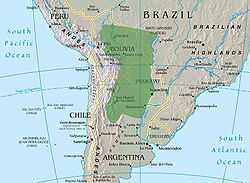Gran Chaco people
 Area of the Gran Chaco | |
| Total population | |
|---|---|
| 300,000 (est. 2010) | |
| Regions with significant populations | |
| Argentina, Brazil, Bolivia, Paraguay | |
| Languages | |
| See text | |
| Religion | |
| traditional tribal religion, Catholic, Protestant, Atheism |
The indigenous Gran Chaco people consist of approximately thirty-five tribal groups in the Gran Chaco of South America. Because, like the Great Plains of North America, the terrain lent itself to a nomadic lifestyle, there is little to no archaeological evidence of their prehistoric occupation. Contributing to this near-absence of archaeological data is the lack of suitable raw material for stone tools or permanent construction and soil conditions that are not conducive to the preservation of organic material.[1][2]
Geography
The actual cultural area of the Gran Chaco peoples differs from that of the geographic Gran Chaco. The northwestern boundary of the cultural area is the Parapetí River and the marshes of the Bañados de Izozog depression, beyond which were the lands of the cultural unrelated Chané and Chiriguano. The cultural boundaries have not been static, even during historical times. In the late 17th century the area expanded to the east across the Paraguay River, when the Mabayá invaded the lands between the Apa River and the Miranda River.[3]
Languages
The tribal groups of the Gran Chaco fall into six language families:[4]
- Matacoan languages or Mataco-maká (Wichí languages, Chorote languages, Nivaclé languages and the Maká language)
- Guaicuruan languages
- Lule–Vilela languages
- Mascoian languages
- Zamucoan languages
- Tupi–Guarani languages
See also
- List of South American Tribes#Gran Chaco
- Gran Chaco#Indigenous peoples of the Gran Chaco
References
- ↑ Combes, Isabelle; Villar, Diego and Lowrey, Kathleen (2009). "Comparative Studies and the South American Gran Chaco". Tipití: Journal of the Society for the Anthropology of Lowland South America 7 (1): 69–102, page 71. Archived from the original on 1 February 2014.
- ↑ Calandra, Horacio Adolfo and Salceda, Susana Alicia (2008). "Cambio y continuidad en el Gran Chaco: De las historias étnicas a la prehistoria". In Braunstein, José and Meichtry, Norma C. Liderazgo, representatividad y control social en el Gran Chaco. Corrientes, Argentina: Universidad Nacional del Nordeste. pp. 31–38, pages 32 & 33. ISBN 978-950-656-116-1.
- ↑ Métraux 1946, p. 197
- ↑ Combes 2009, p. 69
Further reading
- Métraux, Alfred (1946). "Ethnography of the Chaco". In Steward, Julian H. Handbook of South American Indians, Volume 1, The Marginal Tribes. (Bureau of American Ethnology, Bulletin 143). Washington, D.C.: Smithsonian Institution. pp. 197–370.
- Sušnik, Branislava J. (1961). Apuntes de la etnografía Paraguaya, primera parte (second ed.). Asunción, Paraguay: Manuales del Musea Etnografía Andres Barbero.
- Renshaw, John (2002). The Indians of the Paraguayan Chaco: Identity and Economy.